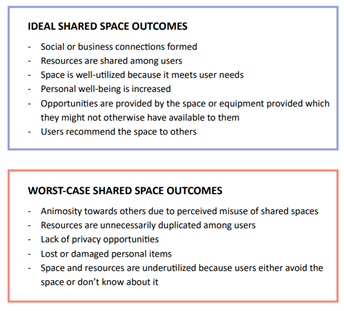
Shared spaces are an important resource in startup and coworking environments for outcomes such as collaboration, networking, wellbeing, and inspiration. Yet, it is not enough to simply provide shared space, but the space should also be well-utilized and provide value to the users by fulfilling their needs. Through the JAVIST project (Jakamisella viisautta / Resourceful Sharing), our goal was to understand user perspectives in shared spaces and identify opportunities to optimize shared space utilization to lead to the positive outcomes previously mentioned. This aligns with a key outcome for the JAVIST project which is to model user experience on sharing. As part of the JAVIST project, we have prepared a report that can be found here.
A brief synopsis of the report can be found below.
Participatory Method: Walkthrough Interviews
To gain insight on users’ perspective of shared spaces, participatory methods were crucial. Therefore, walkthrough interviews were chosen. Walkthrough interviews are semi-structured interviews that occur while the interviewer and the interviewee walk together. In this case, the walks occurred in a startup and coworking building while visiting various shared spaces. Being in the spaces which we were discussing provided detailed and relevant feedback from the users, allowing them to notice or discuss things that they might otherwise not have thought of if they were not in the space at the time. In total, 19 interviewees participated, and 8 spaces were the primary focus of the user discussions.
Shared space outcomes: Ideal & Worst-case:
Based on the interviews, it is clear that shared space outcomes can be powerful in both positive and negative ways. The figure below outlies the ideal shared space outcomes and the worst-case shared space outcomes based on the users’ experiences
This is a summary and analysis of one part of the report.

Empower Users
Users who felt empowered were more likely to utilize shared spaces and resources compared to those users who did not. Therefore, an analysis of user behaviour and potential user attributes were categorized based on the empowerment scale levels including “inhibited”, “empowered”, and “entitled”, with “empowered” resulting in the ideal outcomes. Three opportunities for empowering users are listed below:
Provide Alternative Social Environments
Users expressed a desire for alternative social environments compared to what they currently have access to. The alternative social environments that users described vary, but a common theme was that users would value being around others organically, meaning that these environments wouldn’t require them to pursue socializing but instead facilitate proximity in a casual and low-pressure way. Three potential approaches for providing for this need were suggested and are listed below:
Participatory Feedback of Individual Spaces
Users might not communicate the nuances of how a space works for them or doesn’t work for them unless prompted. Understanding user needs is valuable for enabling shared space to facilitate user goals, maximize utilization, and enhance user experiences in the space. The walkthrough interviews generated many practical insights about individual spaces that could then be provided to building management to be further considered.
Text: Kelly Purcell, Aalto University
Resourceful sharing project is co-funded by European Union. Please find more information on the project HERE.